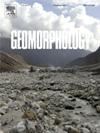Microscale fluvial landscape evolution and its impacts on early human settlement at the Shangshan cultural site in the upper Qiantang region, eastern China
IF 3.1
2区 地球科学
Q2 GEOGRAPHY, PHYSICAL
引用次数: 0
Abstract
Detailed reconstruction of the evolution of fluvial landscapes is important for understanding early human settlement where habitats may be influenced by local river processes. Based on high-resolution geomorphological mapping and sedimentological analyses from five trenches, we reconstructed the geomorphic processes before and after the Shangshan period (10–8.5 ka BP) at the Pujiang Shangshan site in the upper Qiantang region, home to the earliest known rice agricultural population in eastern China. Excavation of paleochannel sediments and analysis of geomorphological features revealed that a migrating river channel and floodplain began developing at least ca. 16 ka cal BP, following extensive eolian sedimentation. By this time, terraces (Q2) formed by the accretion of middle Pleistocene alluvium, had been established, providing ideal Shangshan settlement locations. The Q2 terrace at that time was 5–8 m above the riverbed. Moreover, the identification of later Holocene, small-scale (1–2 m) terraces (Q4), and sedimentary evidence indicate that after the Shangshan occupation, the floodplain experienced prolonged aggradation and channel migration. These river activities greatly altered the fluvial landscapes, reducing both the dimensions of the occupied terrace and its height difference from the riverbed. Our reconstruction reveals that two major aggradations occurred during the late Pleistocene and middle to late Holocene, with dominant lateral accretion observed in the fluvial plain construction of the upper Qiantang region. The aggradational river systems, characterized by wide floodplains and elevated Q2 terraces, provided favorable conditions for rice cultivation and living spaces for early humans, which likely contributed to the emergence of a sedentary agricultural society in eastern China. These results emphasize the importance of river processes in shaping human settlement patterns in the lower Yangtze region and offer insights into Holocene human-environmental relationships. We suggest that similar methodologies can be employed to reconstruct geomorphic processes at other riverine archaeological sites.
求助全文
约1分钟内获得全文
求助全文
来源期刊

Geomorphology
地学-地球科学综合
CiteScore
8.00
自引率
10.30%
发文量
309
审稿时长
3.4 months
期刊介绍:
Our journal''s scope includes geomorphic themes of: tectonics and regional structure; glacial processes and landforms; fluvial sequences, Quaternary environmental change and dating; fluvial processes and landforms; mass movement, slopes and periglacial processes; hillslopes and soil erosion; weathering, karst and soils; aeolian processes and landforms, coastal dunes and arid environments; coastal and marine processes, estuaries and lakes; modelling, theoretical and quantitative geomorphology; DEM, GIS and remote sensing methods and applications; hazards, applied and planetary geomorphology; and volcanics.
 求助内容:
求助内容: 应助结果提醒方式:
应助结果提醒方式:


